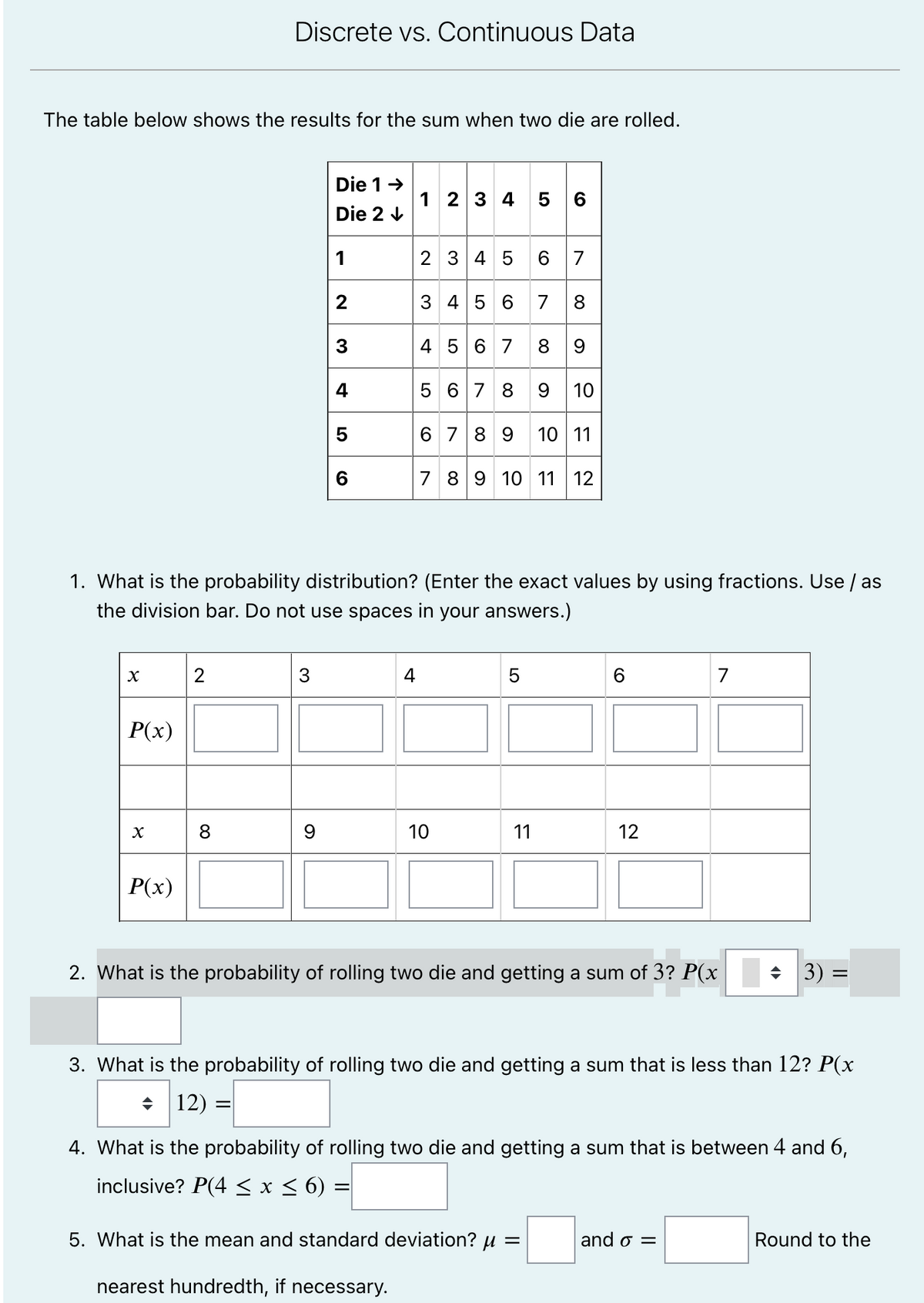Die 1- 1 23 4 6. Die 2 V 1 2 34 5 6. 7 2 3 45 6 7 8 3 4 56 7 9 4 5 67 8 9. 10 5 6 7 8 9 10 11 7 89 10 11 12 1. What is the probability distribution? (Enter the exact values by using fractions. Use / as the division bar. Do not use spaces in your answers.) 2 3 4 5 7 P(x) 8 10 11 12 P(x) 2. What is the probability of rolling two die and getting a sum of 3? P(x + 3) 3. What is the probability of rolling two die and getting a sum that is less than 12? P(x + 12) = 4. What is the probability of rolling two die and getting a sum that is between 4 and 6, inclusive? P(4 < x < 6) = 5. What is the mean and standard deviation? u = and o = Round to the
Die 1- 1 23 4 6. Die 2 V 1 2 34 5 6. 7 2 3 45 6 7 8 3 4 56 7 9 4 5 67 8 9. 10 5 6 7 8 9 10 11 7 89 10 11 12 1. What is the probability distribution? (Enter the exact values by using fractions. Use / as the division bar. Do not use spaces in your answers.) 2 3 4 5 7 P(x) 8 10 11 12 P(x) 2. What is the probability of rolling two die and getting a sum of 3? P(x + 3) 3. What is the probability of rolling two die and getting a sum that is less than 12? P(x + 12) = 4. What is the probability of rolling two die and getting a sum that is between 4 and 6, inclusive? P(4 < x < 6) = 5. What is the mean and standard deviation? u = and o = Round to the
Algebra & Trigonometry with Analytic Geometry
13th Edition
ISBN:9781133382119
Author:Swokowski
Publisher:Swokowski
Chapter10: Sequences, Series, And Probability
Section10.8: Probability
Problem 10E
Related questions
Question
I need help answering these questions.

Transcribed Image Text:Discrete vs. Continuous Data
The table below shows the results for the sum when two die are rolled.
Die 1-
1 2 3 4 5 6
Die 2 V
1
2 3 4 5
6 7
3 4 5 6 7 8
4 5 6 7 8 9
5 67 8 9 10
3
6 789 10 11
7 89 10 11 12
1. What is the probability distribution? (Enter the exact values by using fractions. Use / as
the division bar. Do not use spaces in your answers.)
2
3
4
5
6
7
P(x)
8
10
11
12
P(x)
2. What is the probability of rolling two die and getting a sum of 3? P(x
+ 3) =
3. What is the probability of rolling two die and getting a sum that is less than 12? P(x
+ 12) =|
4. What is the probability of rolling two die and getting a sum that is between 4 and 6,
inclusive? P(4 < x < 6) =
5. What is the mean and standard deviation? u =
and o =
Round to the
nearest hundredth, if necessary.
LO
4-
Expert Solution
This question has been solved!
Explore an expertly crafted, step-by-step solution for a thorough understanding of key concepts.
This is a popular solution!
Trending now
This is a popular solution!
Step by step
Solved in 2 steps with 2 images

Recommended textbooks for you

Algebra & Trigonometry with Analytic Geometry
Algebra
ISBN:
9781133382119
Author:
Swokowski
Publisher:
Cengage

Algebra & Trigonometry with Analytic Geometry
Algebra
ISBN:
9781133382119
Author:
Swokowski
Publisher:
Cengage